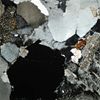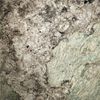Thin Sections Come Home

The recent Geological Curators Group meeting in Guernsey was not just an opportunity for museum staff to swap ideas. Thanks to colleagues from one of the national museums it also allowed us to acquire some interesting items for the collection. These will allow us to shed light on an aspect of Guernsey's history which will be completely foreign to most people. In order to explain why (and make clear the pun in the last sentence) a short history lesson is needed...
In the early nineteenth century when a Sheffield man named Henry Clifton Sorby published an account of using a microscope to understand the structure of rocks and minerals, he was initially ridiculed by a conservative establishment. Some scientists of the day found the idea of using a microscope to understand mountains very hard to appreciate. However, the methods of Sorby and like-minded colleagues soon became mainstream science. They involved grinding rock samples thin enough to see through, so that their structure and constituents could be analysed using a polarising microscope. A new branch of geology was born and for more than a century such microscopy became one of the standard techniques for analysing geological materials.
Today there are many more sophisticated scientific techniques used in the analysis of rocks and minerals. These mostly involve expensive equipment offering facilities like electron microscopy, spectrometry or x-ray diffraction. Such equipment and the associated expertise to use it is way beyond the remit of any institution without a primary research mission and a substantial budget.
At the recent GCG meeting to Guernsey, it was therefore nice to hear that the humble thin section which gave such a huge impetus to the early study of rocks is still in use today. Staff from the National Museum of Wales collected a few beach pebbles of typical local rocks while they were here in the island with the intention of sectioning them back at their Cardiff base. At our request a thin section of each was also sent back for our own collection, together with photographs of the sections in both plane and cross polarised light. The lead photo above shows the three microscope slides as received; the gallery below shows the three pairs of photomicrographs.
While it is beyond the scope of this note to explain in detail what the images show, most would agree that these highly magnified views of Guernsey granite and gabbro varieties are both interesting and attractive to the eye. They will also help us interpret Guernsey's geological history in future museum displays.


















